
 Imperial Japanese Navy, Fleet Armoured Aircraft Carrier 1941-44.
Imperial Japanese Navy, Fleet Armoured Aircraft Carrier 1941-44.WW2 IJN Aircraft Carriers:
Hōshō | Akagi | Kaga | Ryūjō | Sōryū | Hiryū | Shōkaku class | Zuihō class | Ryūhō | Hiyo class | Chitose class | Mizuho class* | Taihō | Shinano | Unryū class | Taiyo class | Kaiyo | Shinyo | Ibuki |The Imperial Japanese Navy Taihō was a modern Fleet Aircraft Carrier designed as a successor to the Zuikaku class (1940). She was designed to give a quatitative edge to the Japanese, just as Yamato was for capital ships. As the head of a planned serie, IJN Taiho was the first with an armoured flight deck, also integrating a raked funnel in her island, and other novelties, some never implemented (like catapults and an extra lift). However her career was short, as she started in March-April and was sunk in June 1944 at the Battle of the Philippine Sea, doomed by the one single flaw in her design and inept damage control teams.
An armoured fleet carrier with grave flaws

3D Rendition
Taihō (Great Phoenix) was approved for construction in the 1939 4th Supplementary Programme and to speed her design, she was essentially an improved Shōkaku. She was laid down was laid down on 10 July 1941 in Construction number 130, at Kawasaki NyD (Kobe). However the Modified Fleet Replenishment Program of 1942 planned that Taihō was to be the lead vessel of a new generation of Japanese fleet aircraft carriers, seconded by no less than fifteen of a modified Hiryū type design, the Unryū-class and five of an improved Taiho, called the G-15 Project. They were the armoured 1st line and unarmored 2nd line carriers of the 1936 naval plan.
However the industrial situation of Japan, amidst crippling losses caused by US Submarines, dregraded fast, hit by shortages of many kinds and the Navy competed soon for resources with the other branches of the military. Thus, construction dragged on until 7 April 1943 when she was launched, and commissioned after almost a year in 7 March 1944. By then, the strategic situation had dramatically changed: The Kido Butai (1st Air Fleet) had been decimated at Midway, while operations mostly counted on the pair of Shokaku, which lost in between most of their experiences pilots and had been damaged. In March 1944, Japan was definitely in the defensive, and the naval plan was more difficult to enforce, with resources now taken faster to convert escort carriers and ASW vessels.
Nevertheless, IJN Taiho was perhaps one of the most ambitious and successful of the Japanese carriers in WW2, her design bringing many interesting novelties whereas she was criticized at the same time for safety issues in a post-midway context, leading to the G-15 Project. So she remained alone in her class. Most of her pilots being lost in the “great marianna turkey shoot”, she in fact ended her days because of a single torpedo from USS Albacore, and very lucky hit.
The interesting point in the story here is that she was not supposed to sink. However the explosions that ravaged her uncontrollably were mostly the result of a single original design flaw, compounded by particularly poor damage control. This came in full contrast with the USN crews, saving their carriers at several occasions after far worse damage. The scenario repeated itself with the loss of Shinano, torpedoed by USS Archerfish at her first combat sortie on 29 November 1944.
Doctrine

2 Views, drawing.
The Modified Fleet Replenishment Program of 1942 precised to simply design time, a modified Shōkaku. The latter is indeed considered the pinnacle of Japanese fleet carrier design. They were fast, reasonably well armed and protected, and carried the largest air group or any other Japanese carrier at the time. Engineers were tasked to improve on every level. First off, they were asked to create a cheaper and simpler version for future large production and carried more planes.
But the underpinning theory that she was to be essentially a 1st line carrier, closer to the enemy and thus exposed quicker to attack but also more able to deliver a fatal first strike. Unarmoured carriers were to be in second line, and in that case, the future Unryu class. They woukld be exposed by a counter-strike or ‘trigger’ the enemy strike and thus expose the location of opposing forces, to sent a combined devastating counterstrike. Still, the admiralty wanted to muster a sizeable, viable first-strike from its armoured carriers and this was incompatible with threaties (were were in 1936 when wargames exposed that doctrine).
Design development: Project W102/G13

Rear section, IJN Taiho, ONI.
However in 1936, Japan denounced the treaties, only way to carry out their ambitious new naval plan, formulated as 12 battleships, 10 aircraft carriers, 20 armoured cruisers and 8 light cruisers. This Project W02 (later W102) was born in 1937 to fill such need for armoured aircraft carriers; The first drawings were delivered in November that year to be discussed. At first, the design called for a 33,600 ton ship, 250m and 27.7m wide, still capable of 33.4kts and 10,000 nautical at cruise speed, armed with the new twin 10cm AA Type 98 developed at the time. The air group called for 18 planes and three reserve/spare for each category, fighter, dive bombers and torpedo bombers the latter being pushed to 21 and one spare, 57 active, 7 spare total while extra 7 bombers and 5 torpedo planes could be parked on deck for a first strike. The design also incorporated for the first time a hurricane bow.
The design also inciroporated for the first time an upright funnel integrated in the island, but the variant showed an open forecastle and no hurricane bow. What followed was months of protracted development, approved on December 8, 1938 but then refined until December 1939 as Project G-13. Further refinemùent drawn from the war in Europe led to several redesigns so she was eventually laid down on July 10, 1941. This one year was before Midway and she ended quite different a simple modified Shokaku as first intended. The truth is that Japan had in no way the industrial capability to deliver it’s intended fleet or 1st and 2nd line aicraft carriers: The G15 (armored carriers) were not even laid down while the second line Unryu class entered service far too late.
Design of IJN Taihō
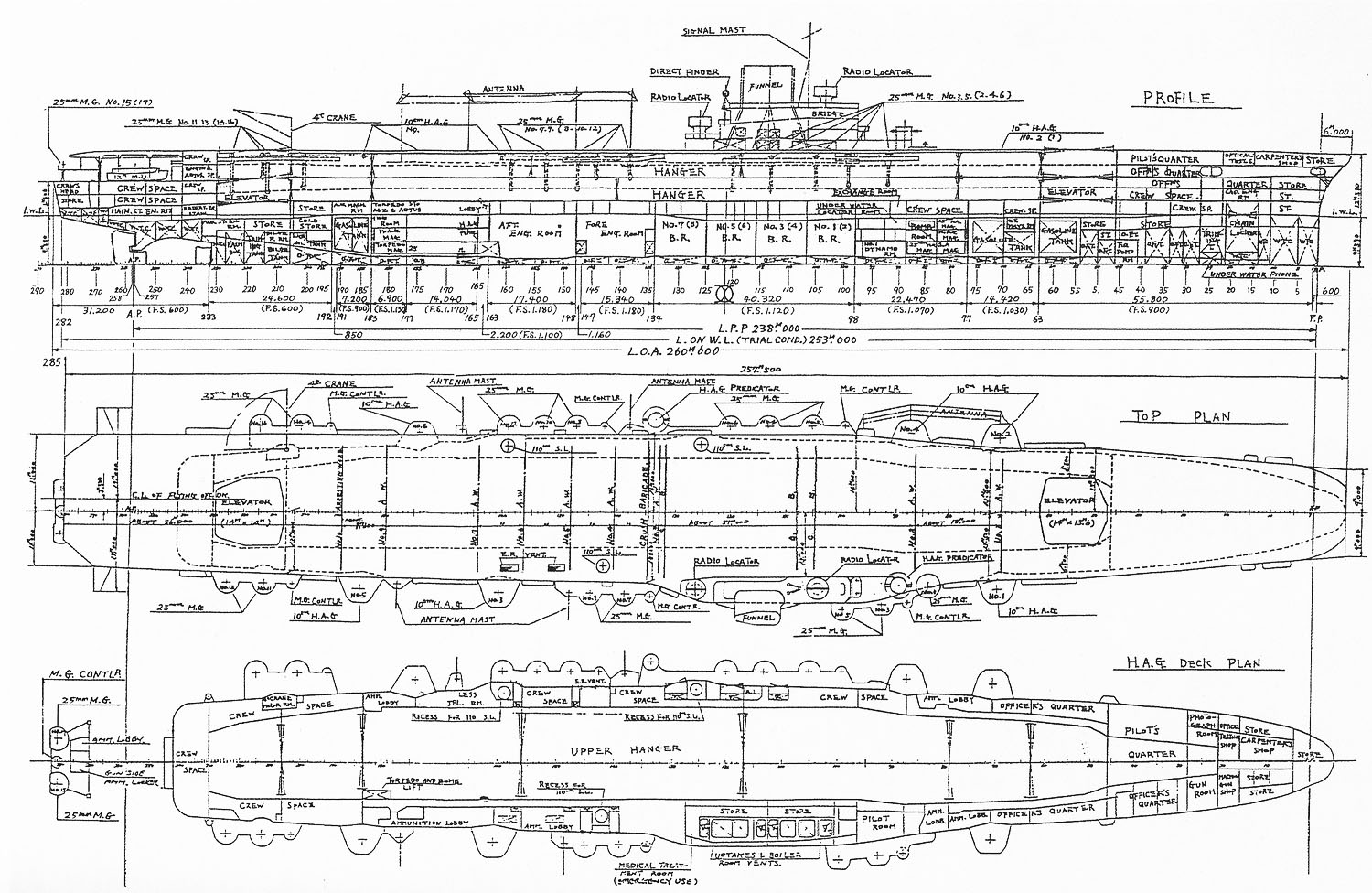
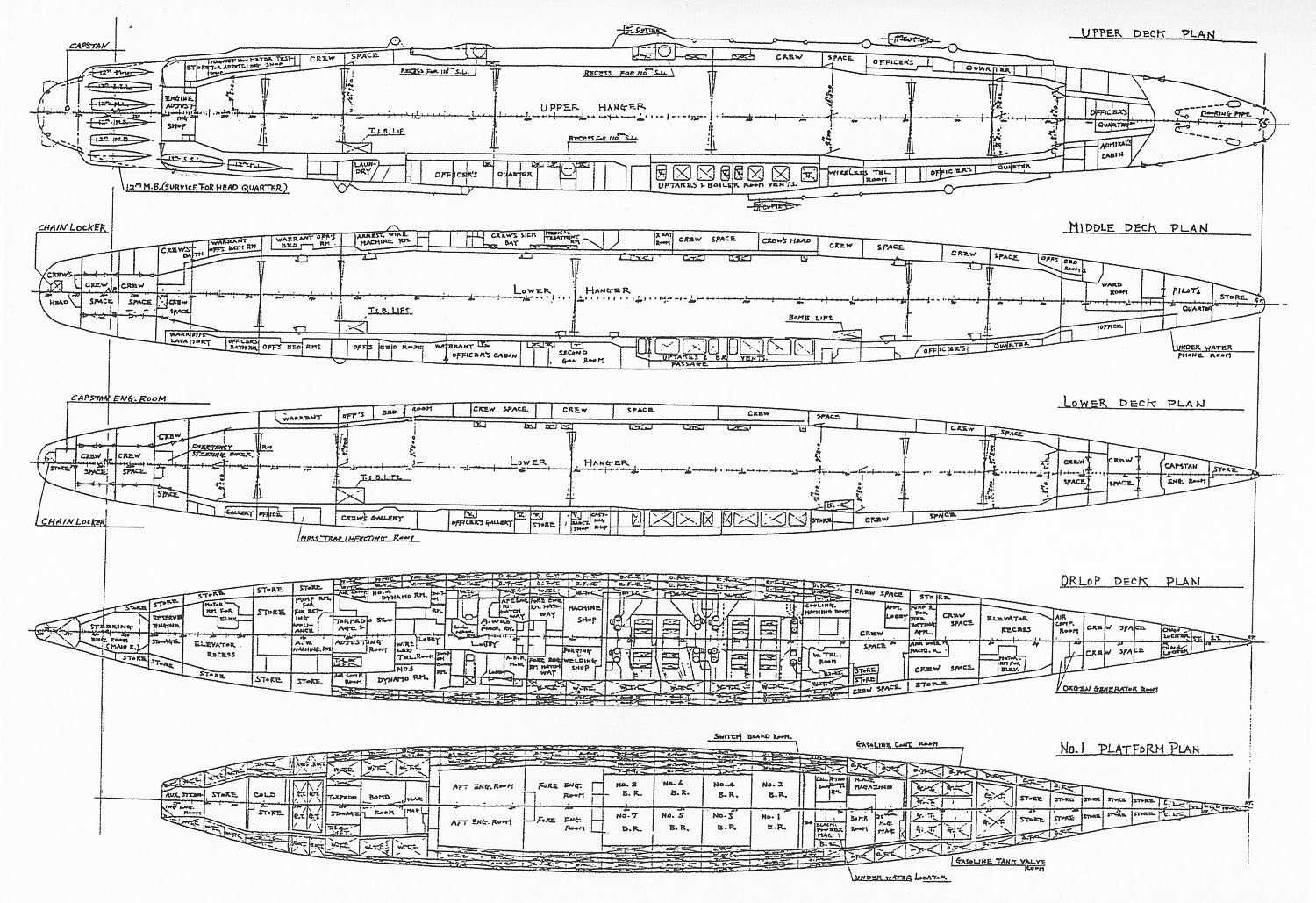
Both: From Encyklopedia Okretow Wojennych 39: Taiho Volume 1
Hull and general caracteristics
The hull was made longer (260 vs 257m) and narrower (27.4 vs 29m), with a slightly higher draft but lesser tonnage overall, from 32,200 to 29,770 tonnes standard while the hull shape wwas supposed to procure a greater speed at equal power. But it was not the case. From the same 160,000 shp, Taiho obtained 33.3 kts though, compared to 34.5 on the Shokakus, but improved slightly on autonomy at 10,000 nm. However the design was suppose to have more planes and an armored deck, which was its main interest.
Taihō had an island in which a single large funnel was built in, but angled 26° to starboard, with all exhaust gases tunctated in. This arrangement helped keeping the smoke out of the flight deck but was atypical of most Japanese carriers. This was considered a success and reproduced on the Junyō and Hiyō conversion as well later on IJN Shinano.
Three Type 96 searchlights were installed on the edges of the flight deck on the port side, one to starboard aft of the island. They could be lowered below flight deck level to allow normal flight activity. The fourth searchlight located on the starboard side island, was installed on a projecting sponson and permament.
Powerplant
There was nothing particularly impressive or innovatove on that chapter. IJN Taiho was given four propeller, on shafts driven by four Kampon geared steam turbines. They were located in their own separated compartment, as well as the eight large oil-fired Kampon RO-GO boilers (two per room), for a total output of 160,000 shp (120,000 kW), the same as the previous Shokaku. This made for a top speed of 33.3 kn (61.7 km/h; 38.3 mph). However more oil was carried, 5,700 short tons, making for 10,000 nmi (19,000 km; 12,000 mi) at 18 kn.
The was an agile ship though, with two rudders along the longitudinal center-line, one semi-balanced, main, requiring less force to turn astern and an unbalanced auxiliary rudder forward of it. They were turned by a system of electro-hydraulically powered steering gears and in case of failure there was a diesel backup for the auxiliary one. This was innovative compared to the Shokaku class. As a note, she also had a more pronounced bulge on her bow, believed to improve her hydrodynamics. Her tactical diameter was 1,012 m (), when full hard rudder port or starboard.
Protection, active and passive
Passive protection

2 Views showing the hangar outline
The general same scheme was repeated, with an armored Belt between 55 to 152 mm thick (2.2–6.0 in) at the waist and tapered down to 40 mm (1.6 in) below the waterline. It varied over various areas, being the thinnest, 55 mm (2.2 in) abreast the machinery, and the largest, 152 mm (6 in) around the magazines. It was designed to resist to a 300 kg (660 Ib) explosive warhread, common on torpedoes. However these figures were generally inferior to the Shokaku. In addition to her flight deck and lower hangar, both elevators were armoured. Her final displacement and draft however was greater than expected and and lower hangar deck was barlerly above the waterline, both bottoms of her elevator wells were below it, which were major flooding hazards. This played a huge part in her loss.
Taihō was the first Japanese aircraft carrier with an armored flight deck, something learned from British actions in 1941-42 in the Mediterranean. The flight deck was designed indeed to withstand multiple 500 kg (1,100 lb) bomb hits with reduced damaged. There were various protective areas on more or less enseible parts, about 75–80 mm (3.0–3.1 in). This was a sort of extra layer over the proper enclosed upper hangar. Its sides and ends were not protected however. The upper hangar floor also was unarmored but the lower hangar deck itself was 32 mm (1.3 in) thick. There is no particular information about an equivalent to the US STS steel use; but Japanese steel was in general of overall better quality by its composition and foundry methods. Another borrowing of British CVs was the plated bow up to flight deck level like on the Illustrious-class.
Her aviation fuel tanks (avgas) were only partially armor protected. Her designers preferred to focus on the bomb and torpedo magazines instead. Empty air spaces around the aviation fuel tanks were in hindsight, a completely overlooked hazard, as fumes or heat can built up there; After her loss, this had them filled with concrete on Shinano and the Unryu class.
In a general way, the weight of her armour forced designers to have her sit down considerably more than other Japanese designs, which a lower hangar way too low above the waterline, for the sake of stability.
Active hangars fire protection
Fire safety was even better designed compared to the Shokaku, although the same main solutions were reused: The two hangars were divided into five and four sections in the upper and lower ones respectively. Each of these was separated by fire-proofed fabric curtains which could be deployed rapidly to limit air supply when a fire broke out and delayed the fire from spreading further. There was also an extensive network of piping to spray foam, with two rows of pipes and nozzles along the walls and at the ends. The lower hangar also had an extra carbon dioxide sprayer in case of fuel vapor building-up. But all of this dependded on electrical current and backups were not always ensured.
Armament
On this chapter, IJN Taiho innovated also. She kept the usual combination of dual-purpose guns and 25 mm AA guns but had six twin Type 98, 4 inches (100 mm)/64 naval guns, a much faster type than the 12.7 cm/40 Type 89 naval gun used on the Shokaku and other carriers. They were also used on the light cruiser Ōyodo, and large Akizuki-class destroyers. They were locared under the flight deck level and could not make cross-deck fire, the same design issue than previous carriers. Three either side, two forward port, one aft port, and one starboard forward of the island, two aft. Specs in short:
- Cartidge: 13 kgs (29 lb) 100 x 819mm .R 100 millimetres (3.9 in)
- Elevation: -10° to +90°
- Rate of fire: 20-22 RPM
- Muzzle velocity 1,010 m/s (3,314 ft/s)
- Effective firing range: 14,000 metres (15,000 yd)
- Vertical effective ceiling: 11,000 metres (36,000 ft)
- Maximum firing range: Horizontal:19,500 metres (21,300 yd)
- Maximum Ceiling: 13,000 metres (43,000 ft) at 90°
For closer range she also had firty-one Type 96 25 mm (0.98 in) anti-aircraft cannons in seventeen triple mounts. These were the same models as for previous carriers and their issues are well known: Excessive vibration, slow elevation and traverse, blinding muzzle flash, inadequate sights, work-heavy reload with magazine clips. They were located one either side, eight in three series of sponsons port, and seven starboard plus at the stern, on elevated platform just before the landing lip and above the poop deck. These had practical firing rate of 110–120 rounds per minute and limited to 3 km (1.6 nmi; 1.9 mi) range.
To serve the dual purpose guns, two Type 94 triaxially stabilized fire control directors were mounted on either side, on the flight deck level, starboard, ahead of the island for one. The other was on a sponson port amidships and below flight deck level. They were electro-hydraulically powered. The 25 mm AA guns on their side were controlled by seven Type 95 fire control units on the sponsons controlling each 2-3 mounts.
Radars
Taihō’s original design had no radar installation by September 1939 as no existed. By January 1941 though, to remedy to that huge discrepancy a Japanese naval technical mission arrived in Germany. They started to received blueprints and an example of a pulsed radar, returned to Japan, and by August, the Navy Ministry initiated a crash plan for radar development whioch succeeeded in providing the IJN with the the Type 21 and Type 13 air search radars.
Therefore due to her lenghty construction Taihō was soon planned to be fitted with two Type 21 air search radars: One was mounted atop the island (AA control platform) while the other was located on the lower bridge deck, immediately aft of the island. A single Type 13 air search set with antenna was later added on the signal mast, above the bridge. The Type 21 allowed a detection range of 80 nmi (150 km; 92 mi), the Type 13 54 nmi (100 km; 62 mi).
Aircraft Facilities
Hangars
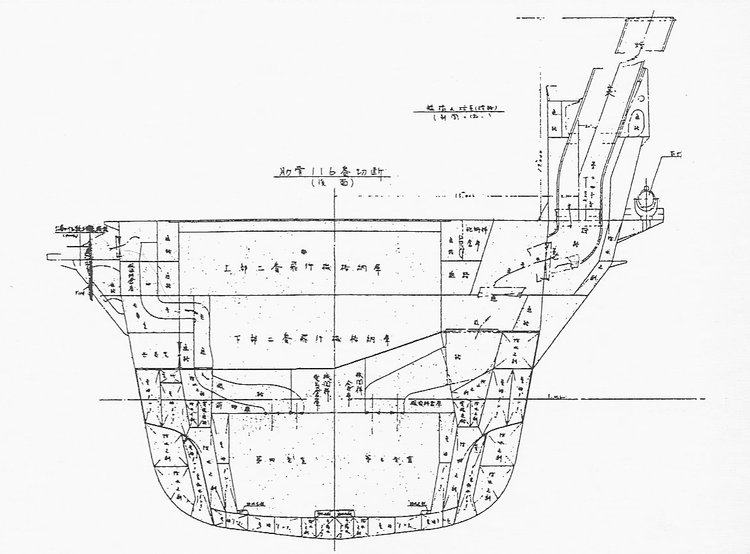
Cut at the island level showing the amidship hangar section
The hangars size and shape was optimized originally to carry up to 82 planes, ten more than the Shokaku (72). Her upper and lower hangars measured 150 m (492 ft 2 in) by 5 m (16 ft 5 in) in height. The upper one however was 1 m (3 ft 3 in) wider than the lower due to the hull shape with an inverted armor plating, sloping downwards. Fighters were stowed in the middle and forward sections, upper hangar and lanched via the bow elevator in rapid handling fashion. Dive bombers, which needed more space to take off, were placed aft in the upper hangar and torpedo bombers were stowed in the lower hangar, using both the aft elevator and were parked far astern. This became the new standard for deck aircraft operation.
Storage
She carried almost double bombs and aviation fuel as other Japanese carriers: For example she carried 990 tons of avgas, while Zuikaku only carried 496 tons. She had ninety 800 kg bombs aboard, four hundred sixty eight 250kg bombs, and the same of 60kg bombs, plus one hundred foorty four 30kg incendiary bomblets. Also forty eight Type 91 Mod 6 torpedoes were stowed aboard, nine could be moved simultaneously through lifts, moved from the lower stowag areas to the lower hangar where torpedo bombers were prepared.
Catapults
Taiho’s original design specified two catapults forward, however, when the ship was close to completion, no workable catapult had been developed for carrier decks and they were simply deleted. Instead, there was the choice of using the more flexible rocket-assisted take-off gear (RATOG). This system used two solid-propellant rockets – using standard cordite- strapped on the aircraft fuselage. They were able to deliver 700 kgf (1,500 lbf) of thrust and burst for just three seconds but did the trick as getting a plane the required speed for take off on a shorter distance. This helped to maximize spotting but the system was in reality rarely used as both dangerous and long to setup.
Elevators
Taihō’s both elevators were armored, roughly pentagonal and weighting 100 long tons (100 t) each. They could lift up to 7.5 long tons (7.6 t) aircraft and served both hangars. One was installed far aft and the other forward of the island with dedicated role, either carrying fighters or torpedo bomber. Plans included at the origin another elevator amidship but for simplification it was cancelled. The elevators were similar in shape and size both 14 m (45 ft 11 in) long and wide. They took 15 seconds to raise or lower an aircraft from the lower level to the flight deck.
Arrestors cables and barriers
The deck was fitted with fourteen hydraulically operated arrester wires transversely across, located between the fore and aft elevators. In addition the new carrier was fitted with three hydraulically powered crash barriers, that can be elevated at each landing and were sometimes used in case of botched landings. Two were abreast the island, one “last chance” at the bow, to avoid collisions with fighters or the elevator.
Flight Deck
The flight deck was in fact the longer of any IJN carrier: It measured as much as long as the hull itself, 257 m (843 ft 2 in) for 30 m (98 ft 5 in) wide which made the largest area. IJN Shinano due to her lvery large island offset to port had otherwide a larger area. IJN Taihō’s flight deck also innovated as being cladded, nbot by wood as was usual, but the steel was covered with latex coating, over 6 mm (0.24 in) in thickness. Not only it was cheaper and lighter, it was faster to apply and repair, and cushioned landings. However this mediocre reacted badly with salty water spray and was bad as anti-skid material, degrading fast, becoming brittle. As usual, the flight deck, which never was camouflages, received landing markings and taking off marks, well visible over the greyish dark deck.
Air Group
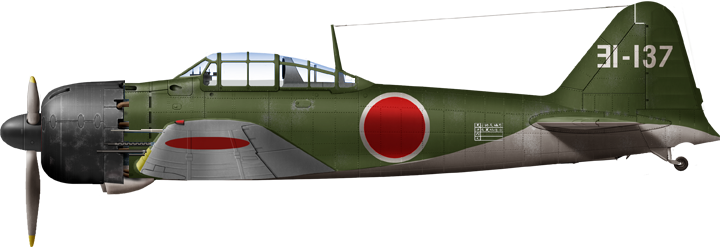
Mitsubishi A6M5 “Zeke” onboard

Yokosuka D4Y1C Suisei (601 kokutai) onboard IJN Taiho, July 1944

Nakajima C6N Saiun “Myrt”. Unfortunately i could not find one belonging specifically to IJN Taiho.
As planned she had the greatest so far of IJN any carrier; past or present (even the gargantuan Shinano carried a pathetic 47 aircraft). However in reality, this was 65 in combat while the shikaku had 72 plus 12 spares and later in wartime, fell to just 52 less spares. Initial prospects (see sources like armouredcarriers.com) in 1941 were for a 63 strong air group with 15 additional reserve so 78 in all: 18 A5M4 “claude”, 18 “Val” and 27 “Kate”.
At the time she was operational in March 1944, she had 27 A6M5 Zero fighters*, 27 Yokosuka D4Y1 Suisei “Judy” dive bombers and 18 Aichi B6N torpedo bombers and three Yokosuka D4Y1C Suisei reconnaisance planes (or Nakajima C6N for other sources probably by mid-1944), for a total of 75 planes which seemed the maximum figure given in most data. However in June it seems down to the following: -22 Mitsubishi A6M5, 22 Yokosuka D4Y, only 3 Aichi D3A and 18 Nakajima B6N. This seems odd as the latter was not offensive, but still, the B6N could carry bombs.
Other sources planned a final 18 Mitsubishi A7M1 Reppū “Sam” fighters (never ready); 36x B7A1 Riusei “Grace” torpedo/dive bombers (replacing both the B6N and D4Y) and six C6N1 “Myrt”, which was more balanced. This was never implemented. 13 aircraft, 7 Grace and 6 Myrts were her permanent deck park. One for a rapid defensive strike, the second for reconnaissance. Fighters coming forward via the first lift could provide a CAP at any notice.
The G-15 project ‘improved Taihō’
Under the 1942 Programme it was supposed to build seven more a few advanced aircraft carriers of Taiho class (G-15 design) with increased area of flight deck (261.5õ29.9m). Two ships were ordered to Kawasaki (No801 and 802) and five to Mitsubishi (No5021-5025). However war and economic situations forced Japanese to refuse this planes. Two slightly improved Taiho’s were listed in the 1942 construction program, as the yet unnamed Hulls 801 and 802.
This revised design was to receive an heavier anti-aircraft batteries, with eight twin duel purpose 100 mm Type 98. To accommodate these and their ammunition stores they were to be even longer, 4m more for 264 m overall, and thus took 1,600 extra tons, but with the same powerplant, resulting in a probable speed loss to 32.5 knots. In the and the Japanese admiralty planned to lay down five of the G15 aicraft carriers by late 1942 (Hulls 5021-5) and eventually if a single one was ordered, none was laid down, based on expected completion time pushed back to 1947-48. Even the most stubborn knew Japan would have been steamrolled well before that and the program was cancelled in favor of the Unryu class and faster cruiser conversions such as the Ibuki class. And with that, the 1936 doctrine was cancelled altogether.

Old author’s illustration of IJN Taiho
⚙ Specs Taihō 1944 |
|
| Dimensions | 260.6 x 27.7 x 9.6 m (855 ft x 89 ft x 31 ft) |
| Displacement | 29,770 t standard, 37,270 t FL |
| Propulsion | 4 Kampon geared steam turbines, 8 Kampon Ro-Go boilers, 160,000 shp (120,000 KW). |
| Speed | 33 knots (61 km/h; 38 mph) |
| Range | 10,000 nmi (19,000 km; 12,000 mi) at 18 knots (33 km/h; 21 mph) |
| Armor | Belt 55–152 mm (2.2–6.0 in), 40 mm (1.6 in) bw, Deck 75–80 mm (3.0–3.1 in)-32 mm (1.3 in) |
| Armament | 6×2 100 mm/65 Type 98 DP, 17×3 (51) Type 96 25 mm AA |
| Aviation & facilities | 65 (82 planned), 1 crane, 2 elevators |
| Crew | 1,750 |
IJN Taiho career

Underway on trials, March 1944
A short service
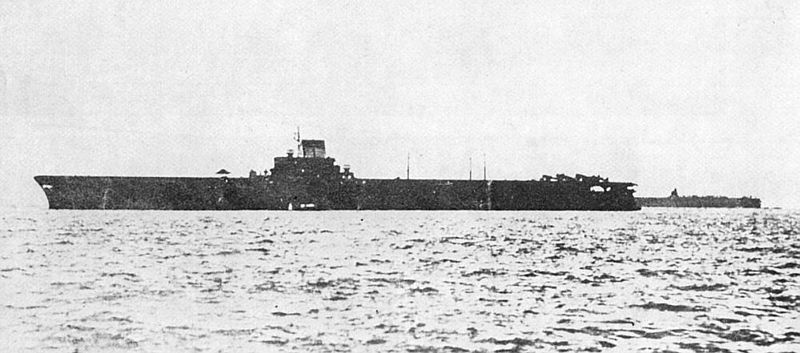
HIJMS Taiho anchored in Tawi-Tawi, the Philippines (May 1944).
IJN Taihō was formally commissioned on 7 March 1944 with Captain Kikuchi Tomozo in command. Several weeks of trials followed, in the safety of Japan’s Inland Sea. She departed Kobe to join the Third Fleet, CarDiv 1, Mobile Fleet and sailed to Kure. On 12 March 1944 she left Kure and final preparation for a first Inland Sea area for a first run of trials. She was back in Kure for fixes on 19 March. She departed on the 24th for Iwakuni, and more intensive training without her air group.
On 27 March she departed Iwakuni for her first mission, at first via a top to Heigun-shima, departing the following day with her escort, the destroyers IJN HATSUZUKI and WAKATSUKI, and bound to Lingga. On 4 April 1944 she arrived at Seletar Naval Base, with IJN Shokaku that she met underway. She deployed first to Singapore mostly for oil reserves and deliver spare aicraft for local defence. From the 5th she trained and on the 15th, arrived at Lingga Roads, her naval anchorage off Sumatra. There, she trained intensively in close coordination with IJN Shōkaku and Zuikaku, forming the First Carrier Division of the First Mobile Force (what was left of the Kido Butai).
All three at that time were the best the IJN had to offer. They trained intensively, practicing launch and recovery, acting as targets for mock aerial attacks from Singapore airfields. On 15 April Vice-Admiral Jisaburo Ozawa transferred his flag to Taihō, appreciating her extensive command facilities. The First Mobile Force departed Lingga for Tawi-Tawi (Borneo) on 14 May 1944. There, the fleet refuelled at Tarakan Island with crude oil, await further orders. Meanwhile, Ozawa worked out and refined Kantai Kessen Operation A-GO. She made a training sortie with her air group pn the 18th. On the 22th it was signalled the Carrier CHITOSE had been attacked by a submarine just outside Tawi Tawi as CarDiv 3 was proceeding to pilot training and Ozawa cancelled further training voyages.
USN carrier strikes against the Marianas immediately signalled the admiralty that Saipan was next. The staff then initiated A-GO on 11 June and Taihō departed Tawi-Tawi on 13 June and went through the Philippine Islands, heading at full speed for Saipan, hoping to surprise the US carrier forces, not yet located. A mission for which Taiho prepared to launch her last air park: nineteen A6M5 “Zeke”, twenty D4Y1 “Judy”, a single D3A2 “Val” and sixteen B6N2 “Jill”. She no longer had her C6Ns initially planned.
On 13 June at 09:30 she departed Tawi Tawi anchorage to head for the Guimaras, a strategic launch spot to await enemy forces attacking Saipan. At 18:30 “A-GO” was activated and further orders transmitted and the following day, at 14h00, she arrived with the division at the Guimaras for overnight layover. There, the Mobile Fleet commenced refueling. On the 15th, at 07:17 executing orders were given per ship. The carriers departed the Guimaras at 08:00 and advanced through San Bernardino Straits, toward Saipan. They proceeded that way through the 16, 17 and 18 June.
Battle of the Philippines Sea

Taihō at anchor at Lingga Roads in April 1944. The carrier Shōkaku is in the background.
On 19 June 1944, IJN Taihō was part of nine Japanese aircraft carriers that took part in the epic battle. At 07:45 her captain ordered she turned into wind for her first strike, comprisng 17 “Judy” dive bombers and nine “Jill” torpedo bombers escorted by 16 A6M5 Zero Fighters: They took off later, as part of the second attack wave. While they were circling overhead to form into formation, the USS Albacore, a Balao class submersible, spotted Ozawa’s carriers earlier and sneaked intop the prefect attack position, to fire a spread of six torpedoes.
Warrant Officer Sakio Komatsu in fact saw the torpedo wakes and broke formation to try deliberately crashing his planed into the path of one torpedo, preventing a hit, while the remaining four missed. The sixth however, hit her just ahead of the island. The explosion blew a hole on her starboard side and the blast also split a joint in the armour above the forward avgas tank and fractured the aviation fuel tanks themselves. They also jammed the forward elevator in an in-between the upper hangar and main flight deck. At this early stage, a small fire broke up, but it was contained by inrushing seawater quickly as to escape more submersibkle attacks, top speed was maintained at 28-27 kts.
Immediately she took a list and flooding down to 1.5 m (5 ft) by the bow while her forward elevator pit, now well below waterline level, was quickly filled with a mixture of seawater, fuel oil and aviation gasoline. Taiho’s captain Kikuchi, still not fully aware of the extent of the damage, order to reduce speed by just 1.5 knot (maintaining a speed of 26 knots) to slow seawater ingress. At that point the damage was “dry” in the sense that no fires had started yet, well controllable. Vice-Admiral Ozawa onboard immediately ordered her open elevator to be planked over by a flight deck damage control party to resume normal flight operations as soon as possible.
By 09:20 am indeed, wooden benches and tables from the petty officers and sailors mess rooms were removed and dismounted, allowing the deck team to complete their task at the satisfaction of Ozawa, ordering the launch of two more waves afterwards, emptying the carrier’s hangar. At that point onboard, officers believed the carrier still could carry one normal operations abnd largely underestimated the damage. As it happened meanwhile, all these waves were sacrificed in the “Mariannas Turkey Shoot”.
Nevertheless, due to the rupture tanks, leaking aviation gasoline accumulated in the forward elevator pit. Soon vapors and fumes reached out the upper and lower hangar decks. The crew there smelled it, recognised the danger, but their response was poor to say the least, disorganized and protracted. After trying to pump out the damaged elevator well, they failed to spray foam or making a proper use of the fire suppression system. This all slowly trigerred a time bomb.
Frantic efforts for nothing
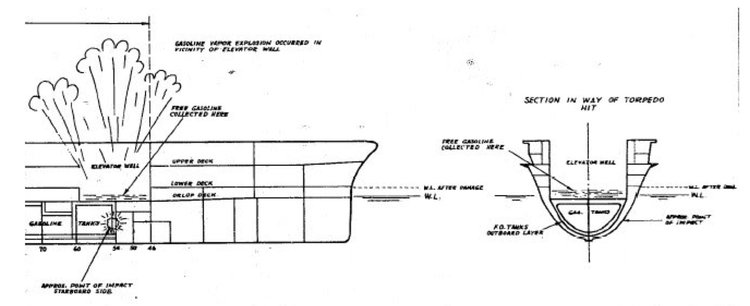
USNI Damage assessment
As her hangars were completely enclosed, mechanical ventilation duct gates were opened at No. 1 and No. 2 sections while the aft elevator was lowered to increase draught, failing however and restructing air operations, until resumed at noon. Damage control teams after hours started to use brute force with hammers to try smash out glass portholes for more ventilation.
Taihō’s chief damage control officer realizing the full amplitude of the issue eventually ordered the general ventilation system switched to full capacity… He also ordered all all doors and hatches opened but it just created drafts which drew more fumes in previously unexposed sections. Now it only was left to a single spark, litterraly, to have the ship burning like a torch, or spontaneous ignition by any cause. The inevitable happened at 14:30, 6½ hours after the torpedo hit that trigerred this chain of events.
Taihō was rocked by a tremendous blast, shattering glass, falling masts, with all crew member lifted off the ground or toasted over. A senior staff officer on the bridge in fact would later testify about the flight deck heaving up, bulging, just before its sides blew out. Needless to say the carrier now crippled, fell out of formation and ceased all normal operations. Speed beld out until she was a stitting duck. Admiral Ozawa refused to transfer his flag to another ship and assumed sharing the fate of her captain, go down with the ship. But his staff for 30 minutes arguing, prevailed, and convinced him to leave. Ozawa transferred his flag to IJN Haguro, taking wit him the Emperor’s portrait, via a destroyer.
There was the possibility of Haguro taking her in tow but this was already out of question and at this point, Captain Kikuchi realizd she was doomed and ordered to abandon ship.
Soon, he turned his gaze back at the carrier with his staff after hearing another tremendous explosion onboard Taihō. The latter was fatal, breaking her hull. The flood was very fast and she sank, stern first at 16:28. She was still settling upright, but leaned over to port while nodding by the bow. All testified that she levelled below the waves on a semi-even keel. There were still 1,650 officers and men that went with her, for Japanese sources, 28 officers and 632 petty officers and men were missing and presumed sank with her. From 2,150 total, about half escaped immediately at the abandon ship order and later recued by destroyers over the next hours.
At 12-05’N, 138-12’E were she sank, Destroyers Iokaze, Wawatsuki and Hatsuzuki rescued indeed some 1,000 officers and men including the Captain. The sinking was so quick all her engine room personnel went with her. Firemen from 2 and 6 boiler rooms however managed to escape topside through overhead deck hatches. She would be stricken much later, on 26 August 1945. News of her sinking were covered up, while the crews were ventilated between active units to avoid spreading the news at home, a common practice at the time.
Sinking and controversy

Colorized photo by Irootoko Jr.
So what went wrong ?
IJN Taiho had many safety features that could have stemmed the damage of properly used, but also a fatal flaw: Sure, her aviation fuel storage facilities were not fully encompassed by the main belt as her torpedo protection system. Now, to be very clear, it’s not the fact that her lower hangar and lift sat very low at waterline level which sunk her. Her machinery was still working as did her pumps and water could have been maintained low, while damage control parties could have try to patch the hole or ensure other compartments around remained tight. It’s the failure of controlling vapors entering both hangars by the teams whoch doomed her. Fortunately enough officers and men survived the sinking to piece together a relatively good picture of what happpened.
For six and a half hours, the teams failed to appreciate the amplitude of the damage and to react accordingly. In less hours allowing the crippled USS Enteprise or Yorktown to survive, the situzaiton onboard Taiho was only worsening. The first explosion and the second intervened in a gap of about two hours between 14 and 16 hours, so the ship sunk in effect eight and a half hours after being torpedoed. USN cadree examining the facts as well as authors well after the war estimated that with her safety measures in place, and even her design issues, with the properly managed and trained damage control parties (at USN standards), no doubt the ship could have, and should have been saved. There was plenty time for it.
For long, her loss has been surrounded by somewhat “mysterious circumstances” and a book was written by Richard Wolff on the subject. Japanese records are unaninmous that the carrier sank nearly on an even keel very much like USS Lexington (CV-2) at Coral Sea and so fuelling the scenario of the greatest explosion forward. But it’s clearly the action of the damage personel that were lacking. Given the action report, it seems they just didn’t know how to deal with the issues. Portable pumps were used in vain, to dump the volatile fuel into the sea but foam sprayers, crucially, were not used.
Perhaps unawaere if the danger, both the Captain and Ozawa prioritiez air operations and directed most efforts into revovering the forward 100ton back into operation, jammed with a loaded, filled A6M5 fighter on it. Basically the lift’s cables slackened, the pulley broke and it partially collapsed, enough to jam into place by it’s own weight.
Damage control parties thus plated over the lift as ordered, but this eliminated chances for any natural ventilation there. To improve airflow opening ventilation ducts were evtentually opened on both sides, further helped by the aft elevator, but with little effect. Soon Ozawa ordered the lift back in use again for air operations. The chief damage control officer also failed to order all ventilation systems activated to full capacity. Her reported the issue and acted far too late. Perhaps panicking at this point, he ordered all doors and hatches opened and portholes broken, but it had the exact opposite effect, spreading furher the heavy fuel-air mixture. When the explosion happened also, the ‘slit’ vents in the hangar sides failed to release the pressure. After the first explosion there was nothing much left to do, the ship was doomed whatever the efforts of the remaining damage parties.

IJN Uryu, to compare.
Sources/ Read more
Books
Conway’s all the worlds fighting ships 1922-1947
Links
On armouredcarriers.com
On combinedfleet.com
Old archive
colorized photos
3D renditions by Waldemar Tubus Góralski
navypedia
wiki
Video: Drachinfels on IJN Taiho – Always train your crew.
The model’s corner

The 1:700 waterline series from Tamiya
The subject has been covered by Japanese brands at 1:700 and 1:350. There are of course tabletop 1:3000 versions. The largest was the Answer-Angraf/CPM 1:200 version. Very Fire created a 1:350, and Fujimi/Tamiya the 1:700. Many photo-etched and decals has been produced as well.
Scalemates general query

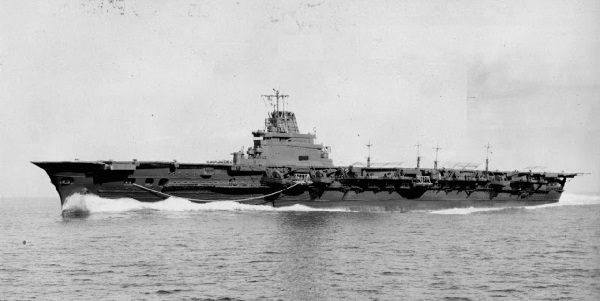
 Latest Facebook Entry -
Latest Facebook Entry -  X(Tweeter) Naval Encyclopedia's deck archive
X(Tweeter) Naval Encyclopedia's deck archive Instagram (@navalencyc)
Instagram (@navalencyc)





 French Navy
French Navy Royal Navy
Royal Navy Russian Navy
Russian Navy Armada Espanola
Armada Espanola Austrian Navy
Austrian Navy K.u.K. Kriegsmarine
K.u.K. Kriegsmarine Dansk Marine
Dansk Marine Nautiko Hellenon
Nautiko Hellenon Koninklije Marine 1870
Koninklije Marine 1870 Marinha do Brasil
Marinha do Brasil Osmanlı Donanması
Osmanlı Donanması Marina Do Peru
Marina Do Peru Marinha do Portugal
Marinha do Portugal Regia Marina 1870
Regia Marina 1870 Nihhon Kaigun 1870
Nihhon Kaigun 1870 Preußische Marine 1870
Preußische Marine 1870 Russkiy Flot 1870
Russkiy Flot 1870 Svenska marinen
Svenska marinen Søværnet
Søværnet Union Navy
Union Navy Confederate Navy
Confederate Navy Armada de Argentina
Armada de Argentina Imperial Chinese Navy
Imperial Chinese Navy Marinha do Portugal
Marinha do Portugal Mexico
Mexico Kaiserliche Marine
Kaiserliche Marine 1898 US Navy
1898 US Navy Sovietskiy Flot
Sovietskiy Flot Royal Canadian Navy
Royal Canadian Navy Royal Australian Navy
Royal Australian Navy RNZN Fleet
RNZN Fleet Chinese Navy 1937
Chinese Navy 1937 Kriegsmarine
Kriegsmarine Chilean Navy
Chilean Navy Danish Navy
Danish Navy Finnish Navy
Finnish Navy Hellenic Navy
Hellenic Navy Polish Navy
Polish Navy Romanian Navy
Romanian Navy Turkish Navy
Turkish Navy Royal Yugoslav Navy
Royal Yugoslav Navy Royal Thai Navy
Royal Thai Navy Minor Navies
Minor Navies Albania
Albania Austria
Austria Belgium
Belgium Columbia
Columbia Costa Rica
Costa Rica Cuba
Cuba Czechoslovakia
Czechoslovakia Dominican Republic
Dominican Republic Haiti
Haiti Hungary
Hungary Honduras
Honduras Estonia
Estonia Iceland
Iceland Eire
Eire Equador
Equador Iran
Iran Iraq
Iraq Latvia
Latvia Liberia
Liberia Lithuania
Lithuania Mandchukuo
Mandchukuo Morocco
Morocco Nicaragua
Nicaragua Persia
Persia San Salvador
San Salvador Sarawak
Sarawak Uruguay
Uruguay Venezuela
Venezuela Zanzibar
Zanzibar Warsaw Pact Navies
Warsaw Pact Navies Bulgaria
Bulgaria Hungary
Hungary

 Bundesmarine
Bundesmarine Dutch Navy
Dutch Navy Hellenic Navy
Hellenic Navy Marina Militare
Marina Militare Yugoslav Navy
Yugoslav Navy Chinese Navy
Chinese Navy Indian Navy
Indian Navy Indonesian Navy
Indonesian Navy JMSDF
JMSDF North Korean Navy
North Korean Navy Pakistani Navy
Pakistani Navy Philippines Navy
Philippines Navy ROKN
ROKN Rep. of Singapore Navy
Rep. of Singapore Navy Taiwanese Navy
Taiwanese Navy IDF Navy
IDF Navy Saudi Navy
Saudi Navy Royal New Zealand Navy
Royal New Zealand Navy Egyptian Navy
Egyptian Navy South African Navy
South African Navy






























 Ukrainian Navy
Ukrainian Navy dbodesign
dbodesign